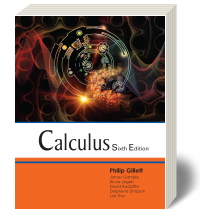Calculus
Sixth Edition Gillett, et al., © 2018, 1040 pages
Calculus seeks to motivate study by using examples based on the questions people would ask while exploring important mathematical ideas. It is written to be read and comprehended by student and instructor alike.
Request Examination Copy Test Drive WebBookPopular Formats (with student pricing)
LAB BOOKPlus ($29 to student)
This format includes our online Book with full access to the lab and study resources.
- eBook (Online - 6 Month)
- Student Solutions Manual
- Coupon for 10% Off (tell me more)
Traditional Print
Our traditional print version of this textbook is available in the following formats:
- TEXTBOOKplus [Loose Leaf / online eBook / downloadable eBook / Lab] ($139)
- Soft cover, perfect bound ($405)
See Prices and ISBNs for bookstore pricing.
Prices and ISBNs
This title is available in the following formats.
|
Product
Description ISBN |
Description | ISBN | Bookstore (Net Price) |
Student (Retail Price) |
|
LAB BOOKPlus
Online eBook + Lab978-1-5178-0521-0 |
Online eBook + Lab | 978-1-5178-0521-0 (9781517805210) | $22 | $29 |
|
TEXTBOOKPlus
Loose Leaf + eBook + Lab 978-1-5178-0186-1 |
Loose Leaf + eBook + Lab | 978-1-5178-0186-1 (9781517801861) | $98 | $139 |
|
Soft Cover
Bound textbook 978-1-5178-0184-7 |
Bound textbook | 978-1-5178-0184-7 (9781517801847) | $285 | $405 |
Supplements
The available Supplements are listed below:
Click here to access ancillaries save_altInstant Access (and Coupons)
All students can have free Instant Access to an eBook for the first two weeks of class while they procure their textbook. They will also receive a 10%-off coupon valid at the BVT web store for the best possible price. Get instant access codes here.
Instructors Solutions Manual
The Instructor Solutions Manual contains a PDF of solutions that accompany the problem sets within each chapter of the textbook.Testbank Questions
The Testbank Questions contains a PDF and Word formats of the test bank for your convenience.Testbank Solutions
The Testbank Solutions contains a PDF and Word formats of the test bank solutions for your convenience.Excerpts
Description
Concepts are presented in a familiar order. However, in keeping with Gillett's vision, this is not a text that reduces major ideas to a lackluster list of definitions, theorems, proofs, and examples. Rather, this text seeks to motivate study by using examples based on the questions one would ask while exploring important ideas. The definitions, theorems, and proofs are then drawn out as natural consequences.
As in previous editions, chapter openers present real-world examples of concepts featured in the chapter and are designed to pique the interest of students and serve as a starting point for motivated study. These examples were originally intended to inspire students to explore concepts more thoroughly through discussion, research, and projects; the team of authors updating this text have honored that intention by bringing examples up to date with the latest technologies and career opportunities.
Practice problems not only serve as a way for students to develop fundamental techniques but also invoke deeper consideration of key concepts. As they work through these problems, students will draw conclusions and relate ideas from precalculus and other fields like physics, chemistry, and engineering, to name a few. Even though technology is now prevalent in mathematics, this text depends heavily on the pencil-and-paper techniques of a traditional calculus text. Basic approaches remain the focus, but technology is not ignored entirely. For example, many of the exploration problems involve the use of graphing technology and should be done using a graphing calculator.
This new edition continues to cover single variable calculus for the first fourteen chapters. These could be used for a two-semester sequence, covering seven chapters per course. The last 6 of the 20 chapters cover vectors, vector functions, multivariable calculus, and differential equations, and could be used for a third-semester course.
Featuring more than 4,700 exercises in problem sets distributed throughout 113 sections, as well as 800 additional exercises included at the ends of the chapters, this book offers a multitude of problems for students to work through. Of these, approximately 90 exercises require a graphing calculator or other sort of graphing technology. However, more important than quantity is quality. An effort was made to include a variety of problems ranging from routine and practice-oriented to thought-provoking and challenging. The application of calculus to other subjects, physics, chemistry, astronomy, engineering, and business, is also included in the exercise sets, emphasizing real-world applicability.

